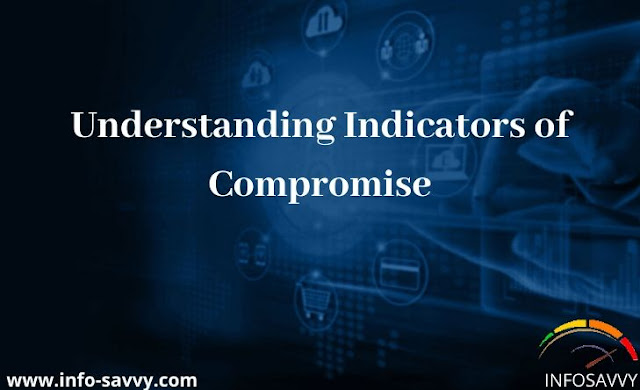Understanding Indicators of Compromise
The Indicators of Compromise play a serious role in building and enhancing the cyber security posture of a company. Monitoring IOCs helps analysts find and answer varied security incidents quickly. Identification of continual concerns of explicit loCs helps the safety groups in enhancing the protection mechanisms and policies to shield and stop varied evolving attacks. This section provides an outline of IOCs and also the in importance, types of IOCs Key IOCs and also the pyramid of pain.
Indicators of Compromise
Cyber threats are endlessly evolving with the newer TTPs custom-made supported the vulnerabilities of the target organization. the safety analysts got to perform continuous observation of loCs to effectively and expeditiously find and answer the evolving cyber threats. Indicators of Compromise area unit the clues/artifact/ items of forensic knowledge that are found on a network or OS of a company that indicates a possible intrusion or malicious activity in organization's infrastructure .
However, loCs are itself not intelligence in reality, IoCs act as a odd supply of information of knowledge of knowledge regarding threats that function data points within the intelligence method. unjust threat intelligence extracted from loCs helps organizations enhance incident-handling methods. Cyber security professionals use varied machine-driven tools to watch loCs to find and stop varied security breaches to the organization. Observation loCs additionally helps the protection groups enhance
the security controls and policies of the organization to find and block the suspicious traffic to thwart any attacks. to beat the threats related to loCs, some organizations like STIX and TAXl l have developed standardized reports that contain condensed knowledge associated with the attack and shared it with others to leverage the incident response.
An loC is outlined as associate atomic indicator, computed indicator, or activity indicator. it's the data concerning suspicious or malicious activities that is collected from varied security institutions during a network infrastructure. Atomic indicators are those who can not be meta-metric into smaller components, associated their which means isn't modified within the context of an intrusion. samples of atomic indicators are information address, email address, etc. Computed indicators are that obtained from the info extracted from a security incident. Samples of computed indicators are hash values and regular expressions. Activity indicators check with a grouping of each atomic and computed indicators combined supported some logic.
Why Indicators of Compromise Important?
Indicators of Compromise act as a chunk of forensic information that helps organizations discover malicious activity at an initial section. These activities that are sometimes labelled as red flags indicate associate snack that has the potential of compromising system or will cause a knowledge breach.
loCs will be as easy as information or as difficult as malicious code. Therefore, it's troublesome to notice them. Threat analysts sometimes correlate varied loCs and mixture them to investigate a possible threat or an event. Using loCs, organizations will find, identify, and answer anacks or threats before they harm the network. Therefore, observance loCs is important to the organization from security compromises.
Following are the explanations why analyzing loCs is crucial for the organization:
• Helps security analysts in detection information breaches, malware immersion makes an attempt, or different threat activities
• Assists security analysts in knowing "what happened" regarding the attack and helps the analysts observe the behavior and characteristics of malware
• Helps improve latency still as upgrade the detection rate of the threats
• Provides security analysts with information feeds that may be fed into the organization's auto response mechanism or machine-controlled security devices. It helps them perform scans automatically to find if those attacks exist in the setting or not. once loCs follow some pattern or show reverent behavior, analysts will update tools and security policies supported that specific behavior of malware .
Helps analysts to find answers to the subsequent questions:
Does the file include malicious content?
Does the organization network compromised?
however did the network get infected?
what's the history of a selected information processing address?
• Assists analysts in following a uniform approach for documentation of every specific threat which will be simply shared with team members
• Provides a better method for the detection of zero-day attacks that detection rules have to be compelled to be developed for the prevailing security tools
• Provides a decent supply of information and a decent place to begin for concluding investigation method.




Completely agree. IT cyber security training is very helpful to develop cyber security skill. Here we offer cyber security training courses online.
ReplyDelete